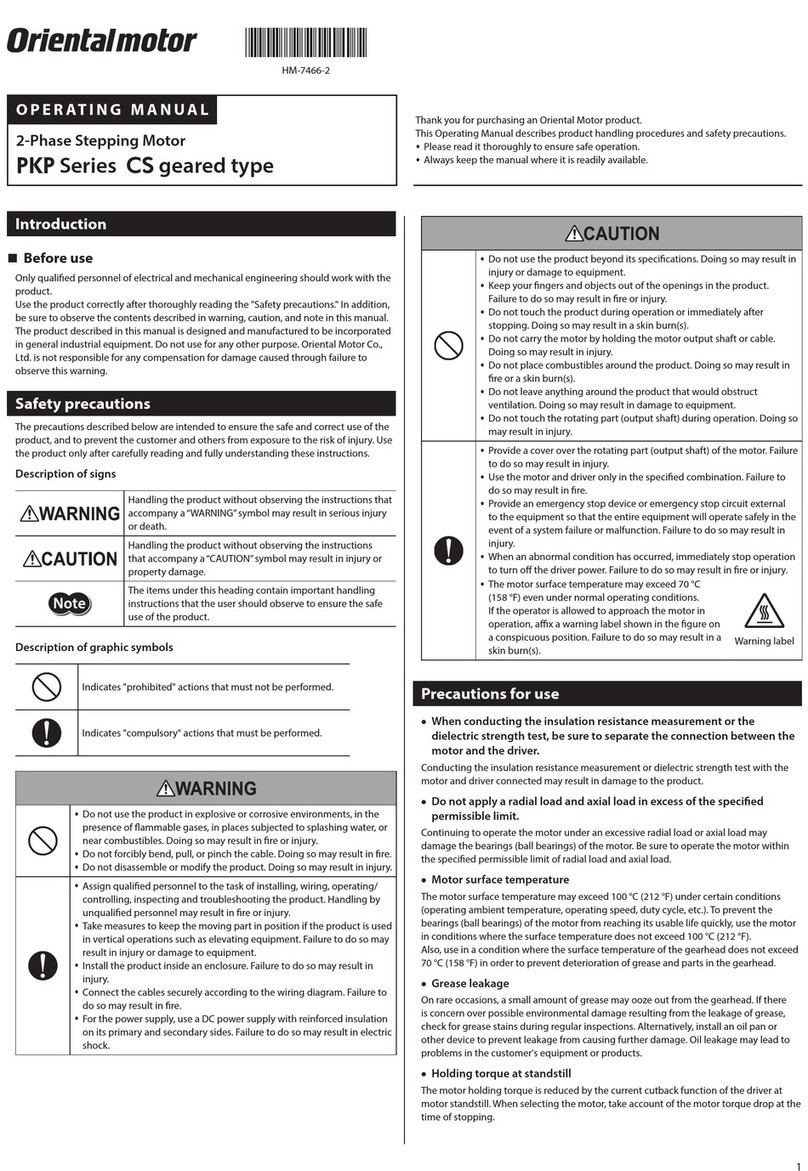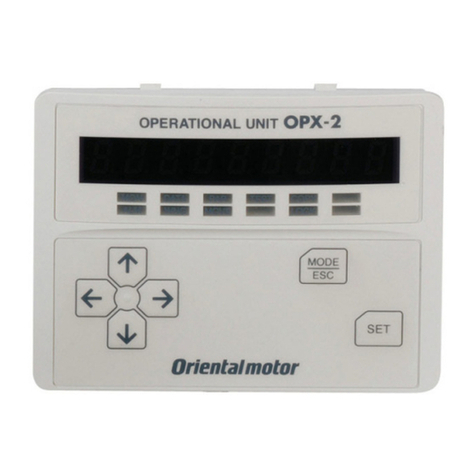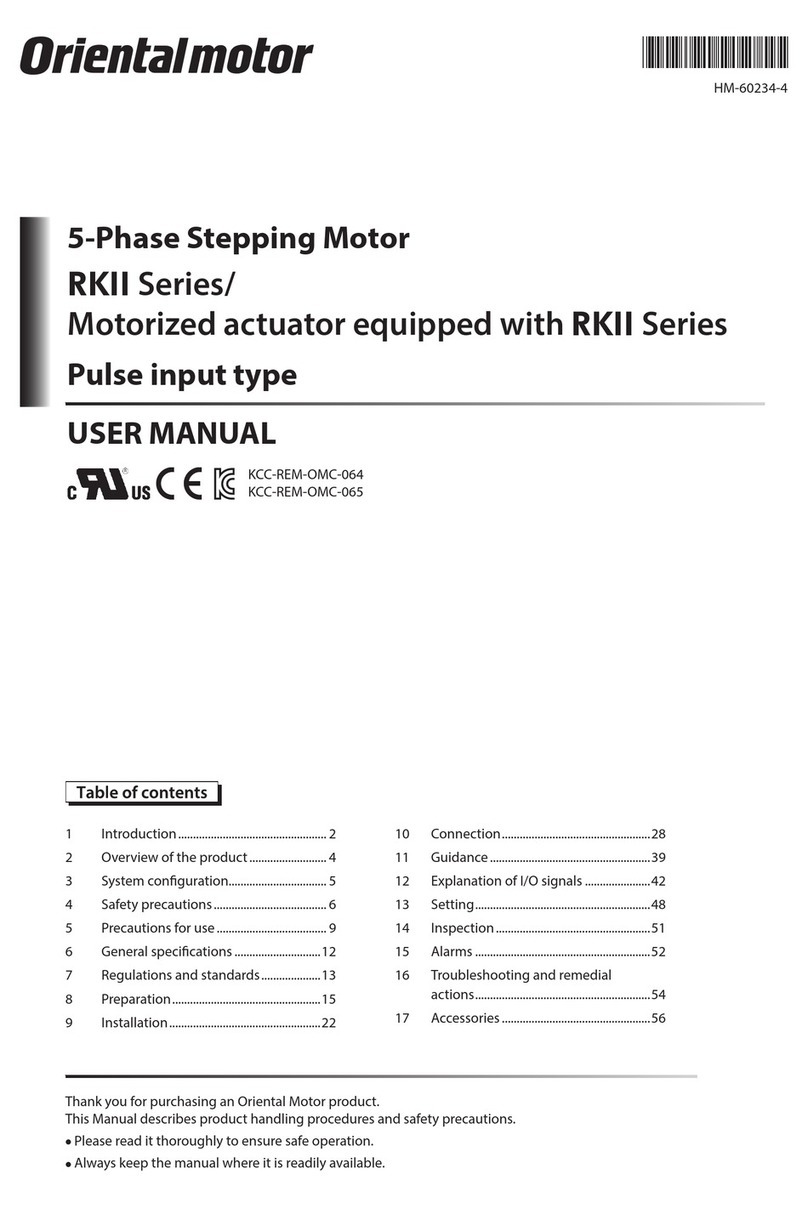
1
Introduction
Before use
Only qualied personnel of electrical and mechanical engineering should work with the
product.
Use the product correctly after thoroughly reading the section "Safety precautions."
In addition, be sure to observe the contents described in warning, caution, and note in
this manual.
The product described in this manual has been designed and manufactured to be
incorporated in general industrial equipment. Do not use for any other purpose. Oriental
Motor Co., Ltd. is not responsible for any damage caused through failure to observe this
warning.
Related operating manuals
For operating manuals not included with the product, contact your nearest Oriental
Motor sales oce or download from Oriental Motor Website Download Page.
Operating manual name Included or not included
with product
AR Series/Motorized actuator equipped with AR Series
OPERATING MANUAL Driver (this document) Included
AR Series/Motorized actuator equipped with AR Series
USER MANUAL Not included
APPENDIX UL Standards for AR Series Included
Safety precautions
The precautions described below are intended to prevent danger or injury to the user
and other personnel through safe, correct use of the product. Use the product only after
carefully reading and fully understanding these instructions.
Description of signs
Handling the product without observing the instructions that
accompany a“WARNING”symbol may result in serious injury
or death.
Handling the product without observing the instructions
that accompany a“CAUTION” symbol may result in injury or
property damage.
The items under this heading contain important handling
instructions that the user should observe to ensure the safe
use of the product.
General
yDo not use the product in explosive or corrosive environments, in the presence of
ammable gases, locations subjected to splashing water, or near combustibles. Doing
so may result in re or injury.
yAssign qualied personnel to the task of installing, wiring, operating/controlling,
inspecting, and troubleshooting the product. Failure to do so may result in re, injury,
or damage to equipment.
yWhen the driver generates an alarm (any of the driver's protective functions is
triggered), the motor will stop and lose its holding torque. Accordingly, provide
measures to hold the moving part in place in the event of an alarm. Failure to do so
may result in injury or damage to equipment.
yWhen the driver generates an alarm (any of the driver's protective functions is
triggered), rst remove the cause and then clear the protection function. Continuing
the operation without removing the cause of the problem may cause malfunction of
the motor and driver, leading to injury or damage to equipment.
Installation
yInstall the driver inside an enclosure. Failure to do so may result in injury.
yWhen installing the driver, install it inside an enclosure so that it is out of the direct
reach of users. Be sure to ground if users can touch it. Failure to do so may result in
electric shock.
Connection
yAlways keep the power supply voltage of the driver within the specied range. Failure
to do so may result in re.
yFor the driver power supply, use a DC power supply with reinforced insulation on its
primary and secondary sides. Failure to do so may result in electric shock.
yConnect the cables securely according to the wiring diagram. Failure to do so may
result in re.
yDo not forcibly bend, pull, or pinch the connection cable. Doing so may result in re.
Operation
yTurn o the driver power supply in the event of a power failure. Otherwise, the
motor may suddenly start when the power is restored, causing injury or damage to
equipment.
yDo not turn the FREE input to ON while the motor is operating. The motor will stop
and lose its holding power. Doing so may result in injury or damage to equipment.
Repair, disassembly, and modication
yDo not disassemble or modify the driver. Doing so may result in injury. Refer all such
internal inspections and repairs to the Oriental Motor sales oce from which you
purchased the product.
General
yDo not use the driver beyond its specications. Doing so may result in injury or
damage to equipment.
yKeep your ngers and objects out of the openings in the driver. Failure to do so may
result in re or injury.
yDo not touch the driver during operation or immediately after stopping. The surface is
hot and may cause a skin burn(s).
yDo not use other batteries than the accessory dedicated battery. Doing so may result
in injury or damage to equipment.
Installation
yDo not leave anything around the driver that would obstruct ventilation. Doing so
may result in damage to equipment.
HM-60187-9
OPERATING MANUAL
Stepping Motor KCC-REM-OMC-068
Thank you for purchasing an Oriental Motor product.
This Operating Manual describes product handling procedures and safety precautions.
yPlease read it thoroughly to ensure safe operation.
yAlways keep the manual where it is readily available.
AR Series/
Motorized actuator equipped with AR Series
DC power input Built-in controller type
Driver


































